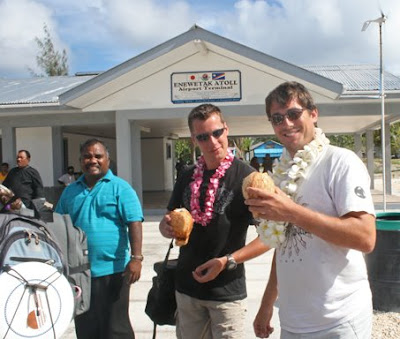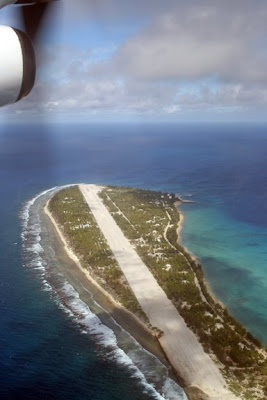Member of the Friends of the Institute for Astronomy
On Wednesday, July 15, the IfA team of 11 met a European contingent of seven at Honolulu International at 5:00 a.m. for a Continental flight to Majuro, the capital of the Marshall Islands. Some of our gear had been shipped ahead, but we carried the essential scientific equipment with us. The scientists would lose an entire year of preparation for collecting data about the Sun’s atmosphere if this equipment didn’t make it to the observing site. This meant careful supervision of the equipment during tagging and security checks, plus visual observation of the cases and bags being loaded onto the plane. No one really cared about personal luggage. The eclipse certainly wouldn’t care what we were wearing or how we looked.
After a five-hour flight, we landed in Majuro on Thursday and trooped down metal stairs onto the tarmac. The country is across the dateline, so it was the next day and two hours earlier local time. (Noon on Wednesday in Honolulu is 10:00 a.m. on Thursday in the Marshall Islands.) Team member Dr. Huw Morgan had already made friends with the co-pilot, and the two of them made sure all our equipment was unloaded before the plane took off for another island nation.
An ancient bus, with small suitcases and carry-on bags piled floor to ceiling behind the driver, delivered us to the Marshall Islands Resort. We calculated that if the driver stopped suddenly, the luggage would fall onto him, not us. Most things in our rooms worked, the pillow was decorated with flowers and a shell necklace, and balconies overlooked the lagoon. The hotel restaurant served good food, as did a couple of other restaurants.
The original Plan B was to take the boat, a 44-hour trip. However, at the last minute the boat company informed Shadia that the boat was leaving for Enewetak on July 13. A chief had died in Kona about a month before (more Enewetakians live on the Big Island than on Enewetak), but now it was essential to return his body to Enewetak as speedily as possible. The boat wouldn’t wait for us, and we couldn’t possibly get to Majuro by the 13th. Scratch Plan B.
Plan C was to enlist the help of the U.S. military, which has a base on Kwajalein Atoll. Shadia located the name of the officer to contact, but he replied that the military couldn’t help due to concerns about the runway and other risks. The motto below his signature said “Attitude is everything.” Scratch Plan C.
So we showed up at the Majuro airport Saturday morning before 5:30 a.m. and boarded the Dash-8 after no ID or security checks. We stopped briefly in Kwajalein to take on more fuel and landed on Enewetak about four hours after leaving Majuro. The runway showed signs of having been paved once. It had no lights or tower, not even a windsock.
The Enewetak community greeted us as we deplaned from the Dash-8.
We stood in front of the airport terminal drinking from coconuts.
This jitney carted us and our luggage around the island.
Enewetak was the site of U.S. nuclear testing in the 1940s and 1950s. The U.S. cleaned up the atoll in 1979, but radiation level monitoring continues. Eclipse team member Judd Johnson constantly monitored our exposure and found little more than the usual background radiation. 
This building contained a kitchen, laundry facilities, bathrooms, and a workroom with half a dozen beds spread around the periphery.
This dormitory contained single and double rooms and bathrooms.
On Monday morning we spent a couple of hours sitting on the airport terminal lanai, with temperatures just below 100 and periodic rain, waiting for the plane to arrive with more food for us. We didn’t go inside the tiny terminal because an anthropologist from Montana State and two of his students were living there for the summer. The plane never arrived. It had taken off but developed an oil leak and returned to Majuro. Now that we were here, we wondered if we would ever get off this atoll.
Although we still didn’t know if the plane would show up the following Saturday to take us back to Majuro, we checked in for the flight on Friday afternoon, using the floor of our workroom as a ticket counter. We weighed ourselves and our carry-on bags, wrote our names and the weights in a notebook, placed our handwritten ticket in a pile on the floor, checked off our names in the book, and took a tag to attach to bags to be loaded into the plane's baggage compartment. The tag was so short that we could barely get it stapled around handles, and we had to tape it to some containers.
On Saturday morning the assistant mayor received word via radio that the plane had taken off from Majuro. Estimated arrival time was 10:45 to 11:15. We loaded up luggage and ourselves in the rain and took off for the airport. The plane touched down at 11:18, the next best sight after the eclipse.
Whether the plane could take off was debatable. Shadia had purchased every seat on the plane so that we could transport our heavy equipment without topping the weight limit. We left some items in Majuro that we deemed non-essential, because we were over the stated weight limit.
After our group dashed through the rain to board the plane, local residents proceeded to board, filling every seat, including the jumpseat in the cockpit, with a couple of people left standing in the aisle. Judd, who is a pilot himself, had a lengthy discussion with the plane’s captain. Finally, two people got off the plane, and—with great hope that the weight numbers showing that we were just at maximum gross weren’t fudged too much—we managed to lift off in the downpour and not plunge into the ocean at the end of the runway.
We landed in Majuro in pouring rain and were given umbrellas at the bottom of the stairs. By the time we got to the terminal, we were drenched anyway, whether from rain or sweat from the mid-day heat we weren’t sure.
The rain was good for Majuro, though. The major source of fresh water is the runoff from the runway that goes into a catchment system. When we returned to the Marshall Islands Resort, we found out that drought rules were in place. We had water for four hours in the morning and three hours in the evening, all of it cold.
We left for home on the Continental flight on Monday, July 27 (Sunday, July 26, in Honolulu). Check-in took an hour and a half, since all checked luggage was searched by hand. The person at the ticket counter checked our passports, but we didn’t need to show a ticket or flight information. There was only one plane leaving that evening. We arrived in Honolulu at 2:30 a.m., ready to begin our second Monday this week.
Grants from NASA and the National Science Foundation funded the solar research done on this trip.



